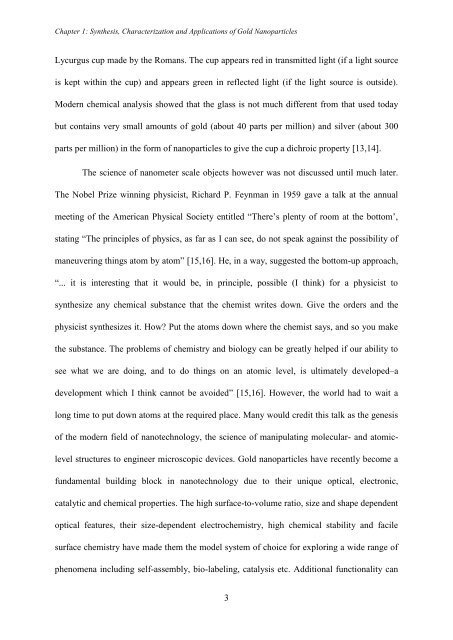PHYS01200704032 Debes Ray - Homi Bhabha National Institute
PHYS01200704032 Debes Ray - Homi Bhabha National Institute
PHYS01200704032 Debes Ray - Homi Bhabha National Institute
Create successful ePaper yourself
Turn your PDF publications into a flip-book with our unique Google optimized e-Paper software.
Chapter 1: Synthesis, Characterization and Applications of Gold Nanoparticles<br />
Lycurgus cup made by the Romans. The cup appears red in transmitted light (if a light source<br />
is kept within the cup) and appears green in reflected light (if the light source is outside).<br />
Modern chemical analysis showed that the glass is not much different from that used today<br />
but contains very small amounts of gold (about 40 parts per million) and silver (about 300<br />
parts per million) in the form of nanoparticles to give the cup a dichroic property [13,14].<br />
The science of nanometer scale objects however was not discussed until much later.<br />
The Nobel Prize winning physicist, Richard P. Feynman in 1959 gave a talk at the annual<br />
meeting of the American Physical Society entitled “There‟s plenty of room at the bottom‟,<br />
stating “The principles of physics, as far as I can see, do not speak against the possibility of<br />
maneuvering things atom by atom” [15,16]. He, in a way, suggested the bottom-up approach,<br />
“... it is interesting that it would be, in principle, possible (I think) for a physicist to<br />
synthesize any chemical substance that the chemist writes down. Give the orders and the<br />
physicist synthesizes it. How? Put the atoms down where the chemist says, and so you make<br />
the substance. The problems of chemistry and biology can be greatly helped if our ability to<br />
see what we are doing, and to do things on an atomic level, is ultimately developed–a<br />
development which I think cannot be avoided” [15,16]. However, the world had to wait a<br />
long time to put down atoms at the required place. Many would credit this talk as the genesis<br />
of the modern field of nanotechnology, the science of manipulating molecular- and atomiclevel<br />
structures to engineer microscopic devices. Gold nanoparticles have recently become a<br />
fundamental building block in nanotechnology due to their unique optical, electronic,<br />
catalytic and chemical properties. The high surface-to-volume ratio, size and shape dependent<br />
optical features, their size-dependent electrochemistry, high chemical stability and facile<br />
surface chemistry have made them the model system of choice for exploring a wide range of<br />
phenomena including self-assembly, bio-labeling, catalysis etc. Additional functionality can<br />
3

















